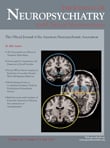REGULARFull Access
Published Online:1 Oct 2007
- Cited by
- Catatonia in patients with dementia: A descriptive study of clinical profiles and treatment responseAsian Journal of Psychiatry, Vol. 96
- Psychiatry Research Case Reports, Vol. 3, No. 1
- 19 July 2023 | Indian Journal of Psychological Medicine, Vol. 46, No. 3
- 8 April 2024 | Indian Journal of Psychological Medicine, Vol. 31
- Schizophrenia Research, Vol. 263
- Katherine Kim,
M.D. , - Rachel Caravella,
M.D. , - Allison Deutch,
M.D. , - Lindsey Gurin,
M.D.
7 July 2023 | The Journal of Neuropsychiatry and Clinical Neurosciences, Vol. 36, No. 1- Katherine Kim,
- 24 November 2023 | Indian Journal of Psychiatry, Vol. 65, No. 11
- 31 August 2023 | Frontiers in Psychiatry, Vol. 14
- Journal of the Academy of Consultation-Liaison Psychiatry, Vol. 64, No. 2
- 21 July 2022 | Journal of Intensive Care Medicine, Vol. 38, No. 2
- Journal of the American Academy of Child & Adolescent Psychiatry, Vol. 61, No. 12
- Epilepsy Research, Vol. 186
- 29 September 2022 | Psikhiatriya, Vol. 20, No. 3
- 29 September 2022 | Frontiers in Molecular Neuroscience, Vol. 15
- 16 August 2022 | International Journal of Environmental Research and Public Health, Vol. 19, No. 16
- Psychiatry Research Case Reports, Vol. 1, No. 1
- 17 May 2020 | Hospital Pharmacy, Vol. 56, No. 5
- 17 June 2020 | Molecular Psychiatry, Vol. 26, No. 1
- 18 February 2020 | International Review of Psychiatry, Vol. 32, No. 5-6
- Asian Journal of Psychiatry, Vol. 52
- 30 October 2019 | CNS Spectrums, Vol. 25, No. 4
- 9 March 2020 | Journal of Evolution of Medical and Dental Sciences, Vol. 9, No. 10
- Psychosomatics, Vol. 61, No. 2
- 17 December 2019 | Journal of Clinical Psychopharmacology, Vol. 40, No. 1
- Schizophrenia Research, Vol. 197
- 7 July 2017 | The Journal of Neuropsychiatry and Clinical Neurosciences, Vol. 29, No. 3
- 14 December 2016 | The International Journal of Psychiatry in Medicine, Vol. 51, No. 5
- Psychiatric Annals, Vol. 46, No. 5
- Mariana Espinola-Nadurille,
M.D., M.P.H. , - Jesus Ramirez-Bermudez,
M.D., Ph.D. , - Gregory L. Fricchione,
M.D. , - M. Carmen Ojeda-Lopez,
M.D. , - Andres F. Perez-González,
M.D. , - Luis C. Aguilar-Venegas,
M.D.
16 December 2015 | The Journal of Neuropsychiatry and Clinical Neurosciences, Vol. 28, No. 2- Mariana Espinola-Nadurille,
- Journal of Psychiatric Practice, Vol. 22, No. 2
- 30 December 2015 | International Journal of Cancer Therapy and Oncology, Vol. 3, No. 4
- Schizophrenia Research, Vol. 168, No. 1-2
- Syndrome catatonique précoce et encéphalite à auto-anticorps antirécepteurs-NMDA : une mise au pointNeuropsychiatrie de l'Enfance et de l'Adolescence, Vol. 63, No. 3
- Valerica Ene-Stroescu,
M.D. , - Thanh Nguyen,
M.D. , and - Brian E. Waiblinger,
M.D.
1 January 2014 | The Journal of Neuropsychiatry and Clinical Neurosciences, Vol. 26, No. 1- Valerica Ene-Stroescu,
- Valerica Ene-Stroescu,
M.D. , - Thanh Nguyen,
M.D. , and - Brian E. Waiblinger,
M.D.
1 January 2014 | The Journal of Neuropsychiatry and Clinical Neurosciences, Vol. 26, No. 1- Valerica Ene-Stroescu,
- Zeitschrift für Kinder- und Jugendpsychiatrie und Psychotherapie, Vol. 41, No. 1
- Cognitive and Behavioral Neurology, Vol. 24, No. 4
- 1 October 2009 | The Journal of Neuropsychiatry and Clinical Neurosciences, Vol. 21, No. 4
- Harvard Review of Psychiatry, Vol. 17, No. 5
Metrics
History
Published online 1 October 2007
Published in print 1 October 2007



